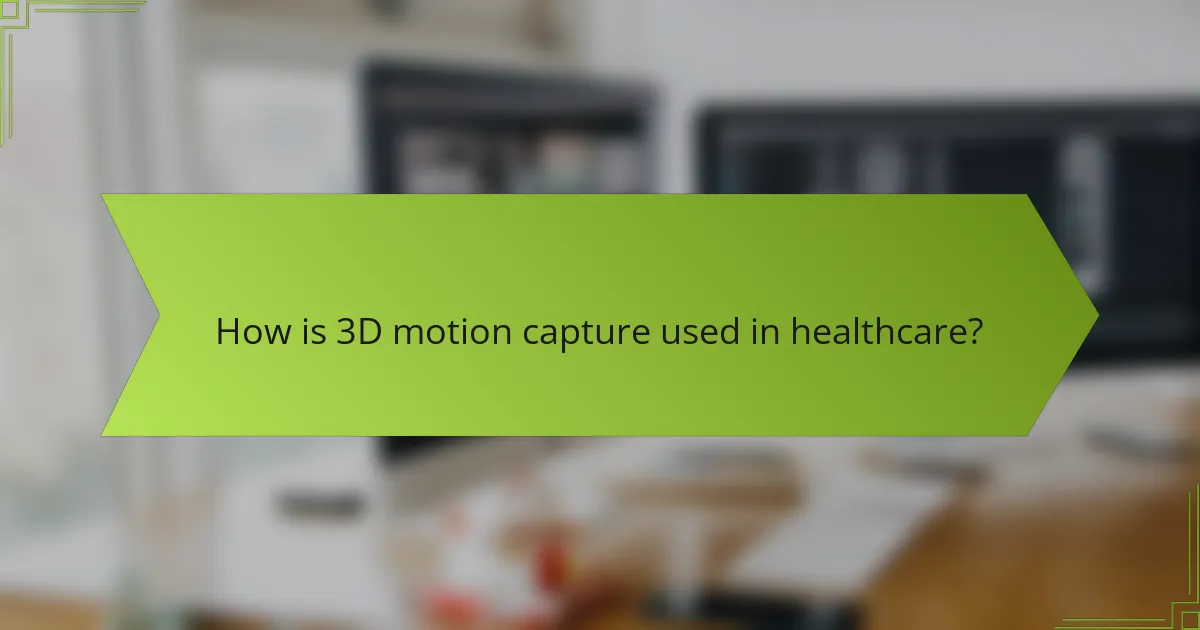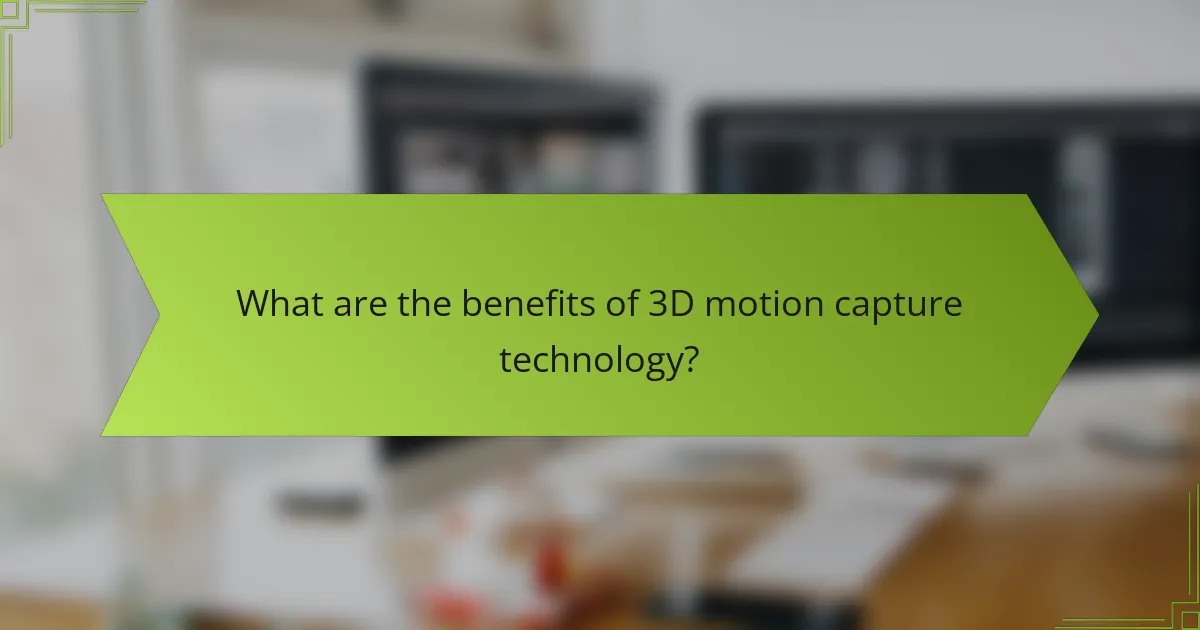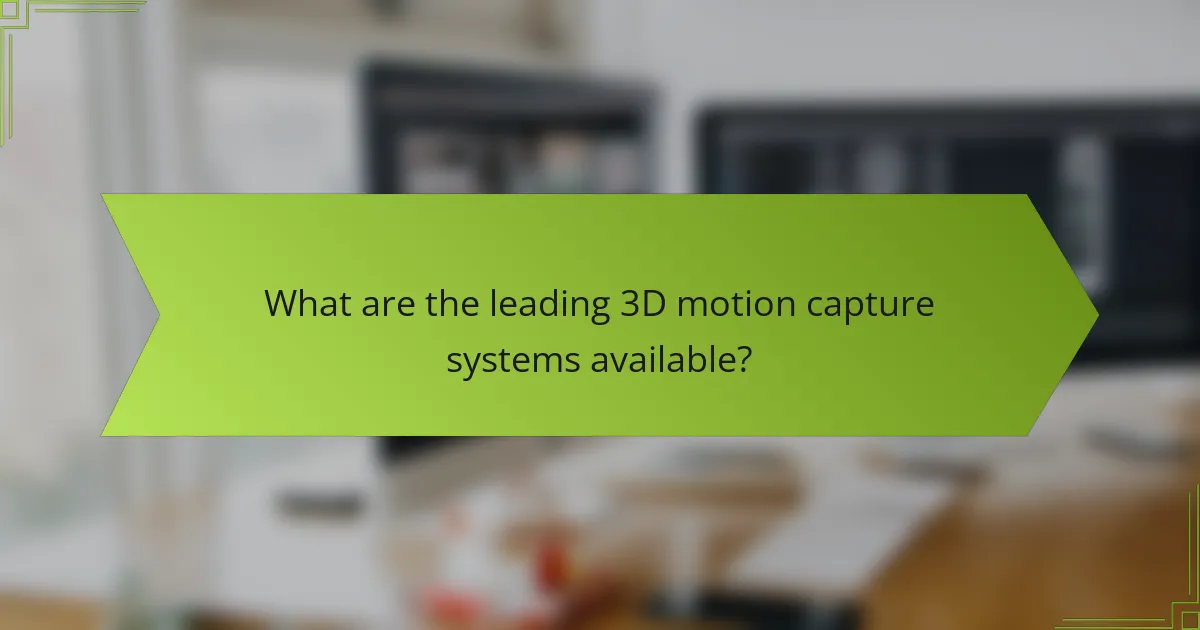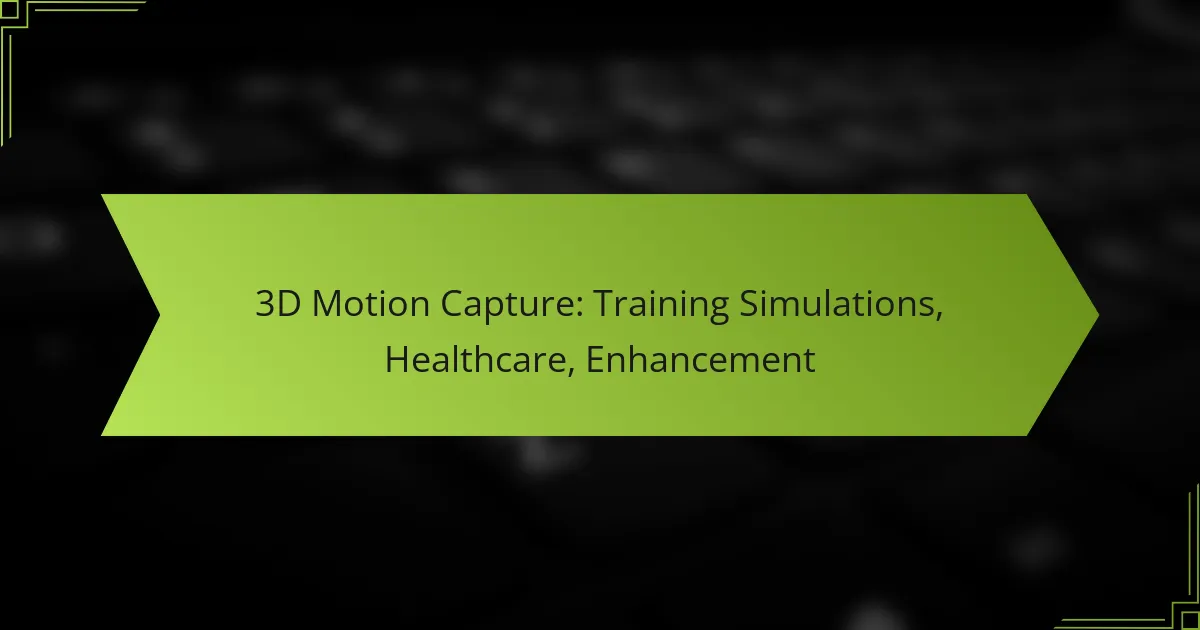3D motion capture technology plays a crucial role in diverse fields such as training simulations and healthcare, offering enhanced realism and precision. By accurately recording human movement, it provides valuable insights that improve skill acquisition, diagnostics, and rehabilitation strategies. This innovative approach not only boosts performance but also tailors interventions to meet individual needs, ultimately leading to better outcomes across various applications.

What are the applications of 3D motion capture in training simulations?
3D motion capture technology is widely used in training simulations to create realistic environments that enhance skill acquisition and performance. By accurately recording and analyzing human movement, it provides valuable insights and feedback that can be applied across various fields.
Realistic skill development
3D motion capture allows trainees to practice skills in a lifelike setting, making the learning process more effective. For example, athletes can refine their techniques by analyzing their movements in real-time, leading to improved performance in their respective sports.
In fields like aviation or military training, realistic simulations help trainees respond to complex scenarios, enhancing their decision-making abilities under pressure. This immersive experience can significantly shorten the learning curve compared to traditional training methods.
Enhanced feedback mechanisms
One of the key advantages of 3D motion capture is its ability to provide precise feedback on performance. Trainees can receive immediate insights into their movements, allowing them to make adjustments on the fly. This instant feedback loop is crucial for mastering complex skills.
For instance, in medical training, surgeons can use motion capture to analyze their hand movements during procedures, identifying areas for improvement. This data-driven approach can lead to higher proficiency and better patient outcomes.
Industry-specific training programs
Different industries leverage 3D motion capture for tailored training programs that meet specific needs. In healthcare, for example, it is used to simulate surgical procedures, enabling medical professionals to practice without risk to patients.
In the entertainment industry, motion capture is essential for animating characters in video games and films, providing actors with a platform to enhance their performances. This cross-industry application demonstrates the versatility of motion capture technology in creating effective training solutions.

How is 3D motion capture used in healthcare?
3D motion capture is utilized in healthcare primarily for improving patient outcomes through enhanced diagnostics, treatment planning, and rehabilitation. By accurately tracking and analyzing movement, healthcare professionals can tailor interventions to individual needs.
Rehabilitation therapy
In rehabilitation therapy, 3D motion capture helps assess a patient’s movement patterns and progress over time. This technology allows therapists to create personalized exercise regimens based on precise data, which can lead to more effective recovery strategies.
For instance, a physical therapist might use motion capture to analyze how a patient walks after an injury. By identifying specific movement deficiencies, the therapist can adjust treatment plans to target those areas, potentially speeding up recovery.
Pre-surgical planning
3D motion capture plays a crucial role in pre-surgical planning by providing detailed insights into a patient’s biomechanics. Surgeons can use this data to simulate surgical outcomes and make informed decisions about the best approach for each individual case.
For example, in orthopedic surgeries, motion capture can help visualize how joint movements will be affected post-operation. This information can lead to more precise surgical techniques and improved patient satisfaction with the results.
Patient monitoring
Patient monitoring with 3D motion capture enables continuous assessment of movement and functionality, particularly in chronic conditions. This technology can track changes in a patient’s mobility over time, providing valuable data for ongoing treatment adjustments.
Healthcare providers can set up motion capture systems in clinical settings or even at home, allowing for real-time feedback. This proactive approach helps in identifying potential complications early, ensuring timely interventions and better management of health conditions.

What are the benefits of 3D motion capture technology?
3D motion capture technology offers numerous advantages across various fields, including training simulations, healthcare, and performance enhancement. Its ability to accurately track and analyze movement leads to improved outcomes and efficiencies in these applications.
Improved accuracy
One of the primary benefits of 3D motion capture is its enhanced accuracy in tracking human movement. This technology captures precise data on body mechanics, allowing for detailed analysis that traditional methods cannot achieve. For instance, in sports training, athletes can receive tailored feedback on their performance, leading to better technique and reduced injury risk.
In healthcare, accurate motion capture aids in rehabilitation by providing objective measurements of patient progress. Clinicians can monitor improvements in mobility and adjust treatment plans based on real-time data, ensuring a more effective recovery process.
Cost-effective solutions
3D motion capture can lead to cost-effective solutions by streamlining processes and reducing the need for extensive physical resources. For example, in training simulations, organizations can create virtual environments that minimize the costs associated with physical setups and equipment. This is particularly beneficial for industries like film and gaming, where creating realistic animations can be expensive.
Moreover, the initial investment in motion capture technology is often offset by long-term savings in training and development costs. By improving efficiency and reducing errors, organizations can achieve a quicker return on investment.
Increased engagement
3D motion capture technology significantly enhances engagement in training and educational settings. By providing immersive and interactive experiences, learners are more likely to stay focused and retain information. For instance, in medical training, realistic simulations using motion capture allow students to practice procedures in a safe environment, increasing their confidence and competence.
In the realm of entertainment, motion capture creates captivating experiences for audiences, as seen in video games and films. This technology allows for lifelike character movements, making stories more relatable and enjoyable, which can lead to higher viewer satisfaction and loyalty.

What are the key factors to consider when choosing a 3D motion capture system?
When selecting a 3D motion capture system, consider system compatibility, budget constraints, and the availability of technical support. These factors will significantly influence the effectiveness and efficiency of your motion capture projects.
System compatibility
System compatibility refers to how well the motion capture technology integrates with existing hardware and software. Ensure that the system can work seamlessly with your current setup, including cameras, sensors, and software platforms.
For example, if you are using specific animation software, verify that the motion capture system supports file formats and protocols used by that software. This can save time and reduce potential issues during the production process.
Budget constraints
Budget constraints play a crucial role in choosing a 3D motion capture system. Systems can vary widely in price, from a few thousand to tens of thousands of dollars, depending on features and capabilities.
Determine your budget early on and consider not just the initial purchase price but also ongoing costs such as maintenance, software licenses, and potential upgrades. Look for systems that offer the best value for your specific needs without overspending.
Technical support availability
Technical support availability is essential for resolving issues quickly and efficiently. A reliable support system can help you troubleshoot problems, ensuring minimal downtime during projects.
Research the support options offered by different manufacturers, including response times, availability of online resources, and access to customer service. Systems with robust support networks can provide peace of mind and enhance your overall experience.

What are the leading 3D motion capture systems available?
The leading 3D motion capture systems include Vicon Vantage, OptiTrack Flex 13, and Motion Analysis Cortex. These systems are widely used in various fields such as training simulations and healthcare, each offering unique features and capabilities suited to different applications.
Vicon Vantage
Vicon Vantage is known for its high precision and flexibility, making it ideal for both academic research and commercial applications. It utilizes advanced algorithms and a robust camera setup to capture motion data with low latency, often in real-time.
This system is particularly effective in environments where detailed motion analysis is required, such as sports science and rehabilitation. Users appreciate its compatibility with various software tools, allowing for seamless integration into existing workflows.
OptiTrack Flex 13
OptiTrack Flex 13 stands out for its portability and ease of use, making it suitable for both lab and field settings. It features lightweight cameras that can be easily set up and repositioned, which is beneficial for dynamic environments.
This system is favored in industries like gaming and virtual reality, where quick setup and high-quality motion capture are essential. Its user-friendly interface and comprehensive support resources help streamline the motion capture process.
Motion Analysis Cortex
Motion Analysis Cortex is a comprehensive software solution that integrates with various hardware setups to provide detailed motion tracking and analysis. It is particularly valued in clinical settings for its ability to analyze gait and other movement patterns.
This system offers extensive customization options and supports a wide range of applications, from sports performance analysis to medical diagnostics. Users should consider its learning curve, as mastering the software may require additional training.
